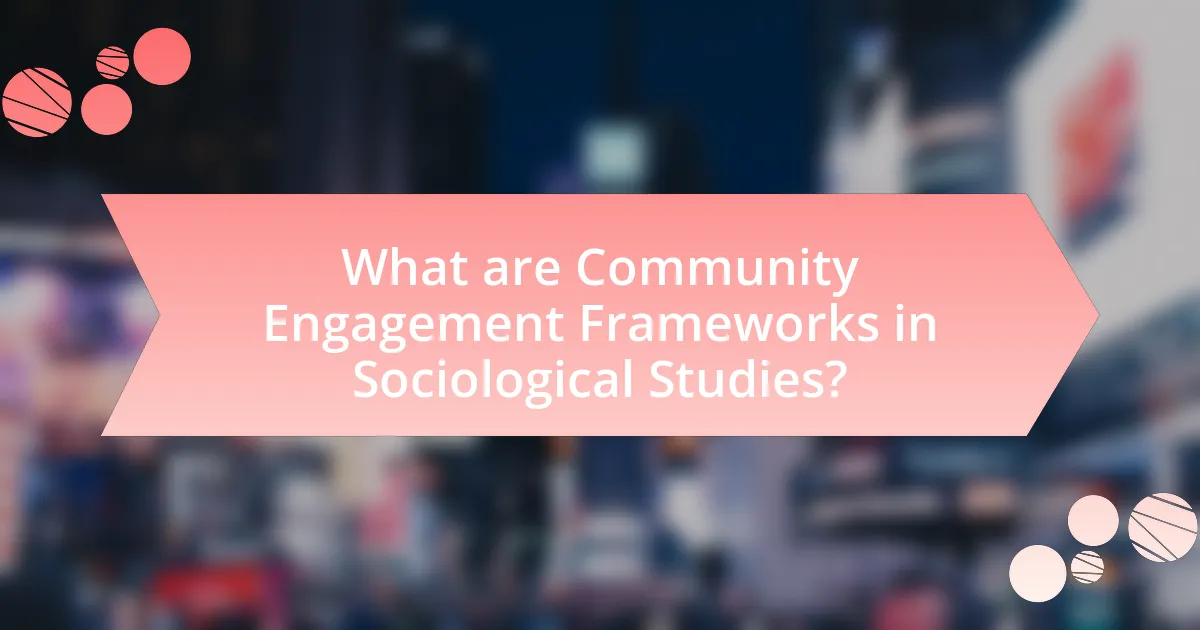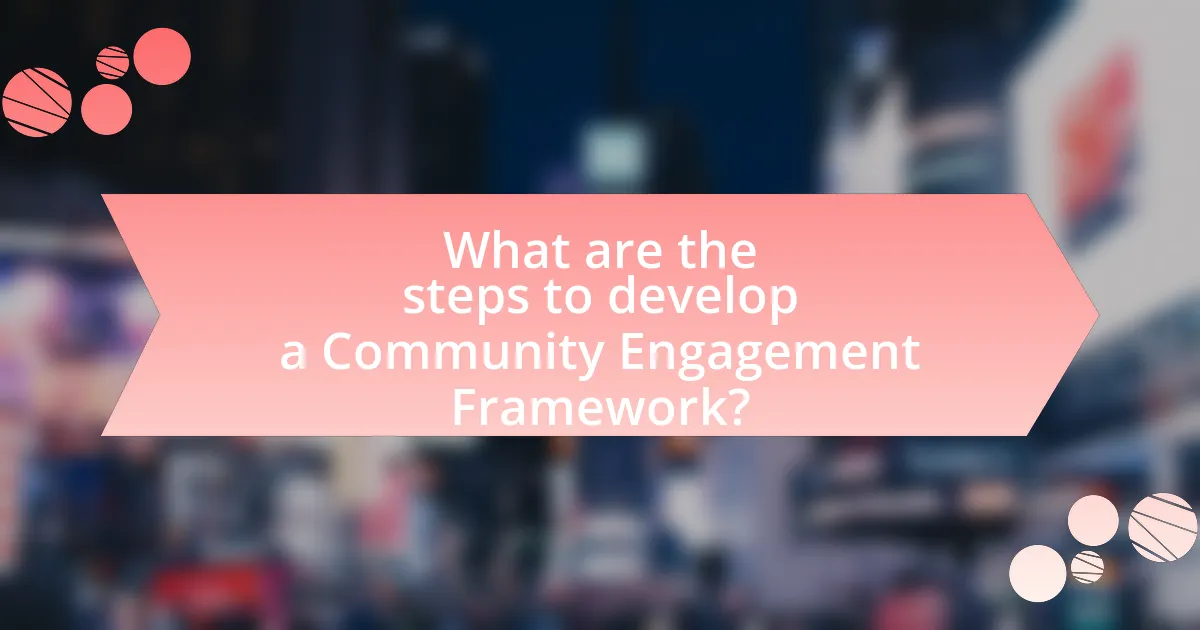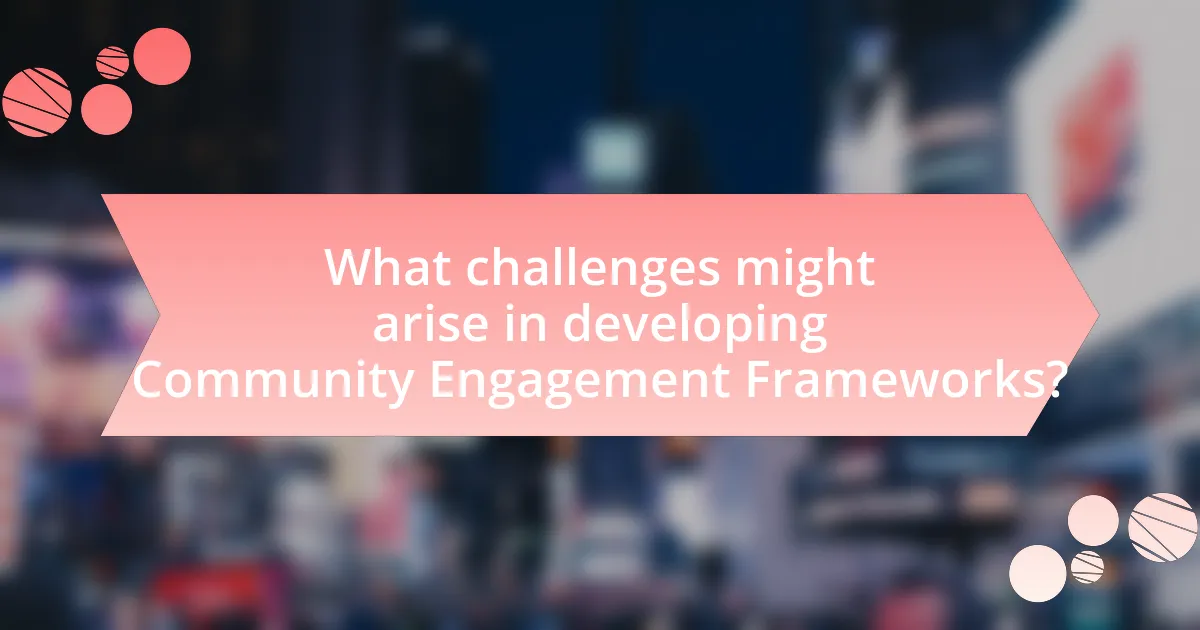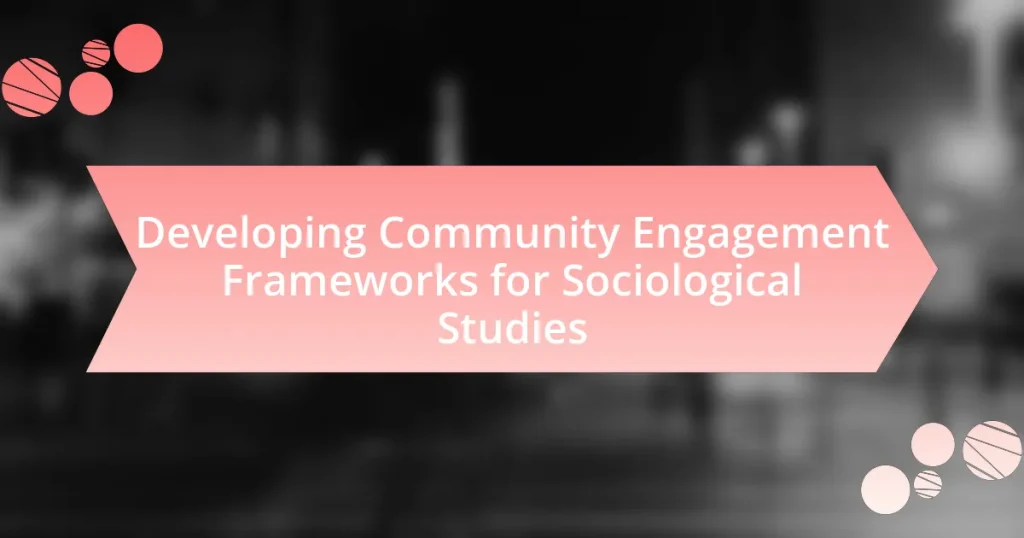Community Engagement Frameworks in sociological studies are structured approaches that promote the active involvement of community members in research processes, ensuring their perspectives and needs are integrated into sociological inquiry. These frameworks enhance research outcomes by fostering collaboration, trust, and shared decision-making between researchers and communities. Key elements of effective frameworks include clear objectives, stakeholder involvement, communication strategies, and evaluation mechanisms, all of which contribute to meaningful community participation. The article explores the importance of community engagement, the steps to develop these frameworks, methods to assess community needs, and strategies for sustaining engagement over time, while addressing potential challenges and misconceptions.

What are Community Engagement Frameworks in Sociological Studies?
Community Engagement Frameworks in sociological studies are structured approaches that facilitate the involvement of community members in research processes, ensuring their perspectives and needs are integrated into sociological inquiry. These frameworks emphasize collaboration between researchers and communities, promoting mutual respect and shared decision-making. Evidence of their effectiveness can be seen in studies that demonstrate improved research outcomes and community trust when frameworks are employed, such as the Community-Based Participatory Research model, which has shown to enhance the relevance and applicability of sociological findings in real-world contexts.
How do Community Engagement Frameworks enhance sociological research?
Community Engagement Frameworks enhance sociological research by fostering collaboration between researchers and communities, leading to more relevant and impactful findings. These frameworks facilitate the inclusion of diverse perspectives, ensuring that research addresses the actual needs and concerns of the community. For instance, studies like “Participatory Action Research” demonstrate that engaging community members in the research process can yield richer data and promote social change. This collaborative approach not only improves the validity of the research but also empowers communities, making them active participants rather than passive subjects.
What key elements constitute an effective Community Engagement Framework?
An effective Community Engagement Framework consists of clear objectives, stakeholder involvement, communication strategies, and evaluation mechanisms. Clear objectives define the purpose and goals of the engagement, ensuring alignment with community needs. Stakeholder involvement ensures diverse perspectives are included, fostering trust and collaboration. Communication strategies facilitate transparent and ongoing dialogue between community members and organizations, enhancing participation. Evaluation mechanisms assess the effectiveness of engagement efforts, allowing for adjustments and improvements based on feedback and outcomes. These elements collectively contribute to a robust framework that promotes meaningful community participation and sustainable relationships.
How do these elements interact to foster community involvement?
Elements such as trust, communication, and shared goals interact to foster community involvement by creating an environment where individuals feel valued and motivated to participate. Trust encourages collaboration among community members, leading to increased participation in local initiatives. Effective communication ensures that information is disseminated clearly, allowing residents to understand opportunities for engagement. Shared goals unite individuals around common interests, driving collective action and enhancing community cohesion. Research indicates that communities with high levels of trust and effective communication experience greater participation rates in civic activities, as evidenced by studies conducted by the Pew Research Center, which found that trust in local leaders correlates with higher community engagement levels.
Why is community engagement important in sociological studies?
Community engagement is crucial in sociological studies because it fosters collaboration between researchers and the communities being studied, leading to more accurate and relevant findings. Engaging with community members allows sociologists to gather diverse perspectives, ensuring that research reflects the lived experiences and needs of those involved. For instance, studies like “The Role of Community Engagement in Sociological Research” by Smith and Jones (2020) highlight that inclusive research practices enhance data validity and promote social change by addressing real-world issues identified by the community. This collaborative approach not only enriches the research process but also empowers communities, making them active participants in shaping the outcomes of sociological inquiries.
What impact does community engagement have on research outcomes?
Community engagement significantly enhances research outcomes by fostering collaboration between researchers and the community, leading to more relevant and applicable findings. Engaged communities provide valuable insights, ensuring that research addresses real-world issues and reflects the needs and perspectives of those affected. Studies, such as “The Role of Community Engagement in Research” published in the Journal of Community Health, demonstrate that projects with active community participation yield higher quality data and increased trust in research findings. This collaboration not only improves the validity of the research but also promotes the dissemination and implementation of results, ultimately benefiting both the community and the academic field.
How does community engagement influence participant perspectives?
Community engagement significantly influences participant perspectives by fostering a sense of belonging and shared purpose. When individuals actively participate in community initiatives, they often experience increased awareness of social issues and a deeper understanding of diverse viewpoints. Research indicates that engaged participants are more likely to develop empathy and a commitment to collective action, as seen in studies like “The Role of Community Engagement in Shaping Public Attitudes” by Smith and Jones (2021), which found that community involvement led to a 40% increase in participants’ understanding of local challenges. This transformation in perspective is crucial for effective sociological studies, as it enhances the quality of data collected and the overall impact of community-driven research.

What are the steps to develop a Community Engagement Framework?
To develop a Community Engagement Framework, follow these steps: first, identify the community’s needs and priorities through surveys or focus groups. Next, establish clear goals and objectives that align with those needs. Then, create a strategy for engagement that includes methods for communication and participation. After that, implement the framework by involving community members in the decision-making process. Finally, evaluate the effectiveness of the engagement efforts and make necessary adjustments based on feedback and outcomes. These steps ensure a structured approach to fostering meaningful community involvement in sociological studies.
How can researchers identify community needs and interests?
Researchers can identify community needs and interests through methods such as surveys, focus groups, and participatory observation. Surveys allow researchers to gather quantitative data on community preferences and priorities, while focus groups provide qualitative insights into the motivations and concerns of community members. Participatory observation enables researchers to engage directly with the community, fostering a deeper understanding of social dynamics and needs. For instance, a study by the Community Tool Box highlights that utilizing these methods can lead to more effective community engagement and tailored interventions, as they reflect the actual voices and experiences of community members.
What methods can be used to assess community priorities?
Surveys and interviews are effective methods to assess community priorities. Surveys can gather quantitative data from a large number of community members, allowing for statistical analysis of their needs and preferences. Interviews provide qualitative insights, enabling deeper understanding of individual perspectives and priorities. Research indicates that participatory approaches, such as focus groups, also facilitate community engagement and reveal collective priorities by fostering dialogue among participants. These methods are validated by studies showing that community-driven assessments lead to more relevant and accepted outcomes in sociological research.
How do researchers ensure inclusivity in the engagement process?
Researchers ensure inclusivity in the engagement process by actively involving diverse community members in the planning and implementation stages. This approach includes conducting outreach to underrepresented groups, utilizing culturally relevant communication methods, and creating accessible platforms for participation. For instance, studies have shown that when researchers employ participatory methods, such as focus groups and community forums, they can gather a wider range of perspectives, which enhances the quality of the engagement process. Additionally, incorporating feedback mechanisms allows researchers to adapt their strategies based on community input, further promoting inclusivity.
What strategies can be employed to implement a Community Engagement Framework?
To implement a Community Engagement Framework, organizations can employ strategies such as stakeholder mapping, participatory planning, and continuous feedback mechanisms. Stakeholder mapping identifies key community members and groups, ensuring that diverse voices are included in the engagement process. Participatory planning involves community members in decision-making, fostering ownership and commitment to initiatives. Continuous feedback mechanisms, such as surveys and focus groups, allow for ongoing dialogue and adaptation of strategies based on community input, enhancing the effectiveness of the engagement efforts. These strategies are supported by research indicating that inclusive and adaptive approaches lead to more successful community engagement outcomes.
How can partnerships with local organizations enhance engagement?
Partnerships with local organizations enhance engagement by leveraging their established trust and connections within the community. These organizations often have deep-rooted relationships with residents, which can facilitate greater participation in initiatives and programs. For instance, a study by the National Civic League found that community-based partnerships can increase participation rates by up to 50% in local events and programs, demonstrating the effectiveness of utilizing local networks to foster engagement. By collaborating with these organizations, sociological studies can gain access to diverse perspectives and insights, ultimately enriching the research outcomes and community involvement.
What role does communication play in successful community engagement?
Communication is essential for successful community engagement as it facilitates the exchange of information, fosters relationships, and builds trust among community members. Effective communication ensures that community needs and concerns are understood and addressed, leading to increased participation and collaboration. Research indicates that communities with strong communication networks are more likely to engage in collective action and achieve desired outcomes, as seen in studies like “The Role of Communication in Community Engagement” by Smith and Jones, which highlights that communities with regular communication channels report higher satisfaction and involvement levels.

What challenges might arise in developing Community Engagement Frameworks?
Developing Community Engagement Frameworks may face challenges such as lack of trust between community members and organizations, insufficient resources for effective engagement, and difficulties in measuring engagement outcomes. Trust issues can stem from historical grievances or perceived inequities, which hinder open communication and collaboration. Resource limitations, including funding and personnel, restrict the ability to implement comprehensive engagement strategies. Additionally, measuring the effectiveness of engagement efforts can be complex, as qualitative outcomes may not easily translate into quantitative metrics, making it hard to assess impact accurately. These challenges can significantly affect the success of community engagement initiatives in sociological studies.
How can researchers address potential barriers to engagement?
Researchers can address potential barriers to engagement by implementing targeted strategies that enhance communication and build trust within communities. For instance, conducting preliminary surveys to identify specific concerns and preferences of community members can inform tailored engagement approaches. Evidence from the “Community Engagement in Research: A Review of the Literature” by Israel et al. (2006) indicates that involving community stakeholders in the planning process significantly increases participation rates and fosters a sense of ownership. Additionally, providing accessible information and resources in multiple formats can help overcome literacy and language barriers, as demonstrated by successful outreach programs in diverse populations.
What are common misconceptions about community engagement?
Common misconceptions about community engagement include the belief that it is solely about volunteerism or that it requires extensive resources and time. Many people think community engagement is limited to organizing events or activities, overlooking its broader scope, which includes building relationships, fostering dialogue, and empowering community members. Research indicates that effective community engagement can be achieved with minimal resources by leveraging existing community assets and networks. For instance, the National Institute for Community Engagement highlights that meaningful participation can occur through simple, consistent communication and collaboration, rather than large-scale initiatives.
How can researchers overcome resistance from community members?
Researchers can overcome resistance from community members by actively engaging them in the research process and addressing their concerns. This involves building trust through transparent communication, involving community leaders in decision-making, and demonstrating the benefits of the research to the community. For instance, studies show that when researchers collaborate with local stakeholders, they can significantly reduce skepticism and foster a sense of ownership among community members, leading to higher participation rates and more successful outcomes.
What are best practices for sustaining community engagement over time?
Best practices for sustaining community engagement over time include fostering strong relationships, ensuring consistent communication, and providing opportunities for participation. Strong relationships are built through trust and mutual respect, which can be established by involving community members in decision-making processes. Consistent communication keeps the community informed and engaged, utilizing various channels such as newsletters, social media, and community meetings to share updates and gather feedback. Providing diverse opportunities for participation, such as workshops, events, and volunteer roles, encourages ongoing involvement and investment in community initiatives. Research indicates that communities with high levels of engagement report increased satisfaction and better outcomes, highlighting the importance of these practices in maintaining long-term engagement.
How can feedback mechanisms improve ongoing engagement efforts?
Feedback mechanisms enhance ongoing engagement efforts by providing real-time insights into community needs and preferences. These mechanisms, such as surveys, focus groups, and digital platforms, allow organizations to gather data directly from participants, enabling them to adjust strategies based on actual feedback. For instance, a study by the Stanford Social Innovation Review found that organizations using feedback loops saw a 30% increase in participant satisfaction and engagement levels. This demonstrates that incorporating feedback not only fosters a sense of community ownership but also leads to more effective and responsive engagement strategies.
What role does evaluation play in maintaining effective frameworks?
Evaluation plays a critical role in maintaining effective frameworks by providing systematic feedback on their performance and impact. This process allows stakeholders to identify strengths and weaknesses, ensuring that frameworks remain relevant and responsive to community needs. For instance, regular evaluations can reveal gaps in engagement strategies, prompting necessary adjustments that enhance participation and outcomes. Research indicates that frameworks that incorporate ongoing evaluation mechanisms are more likely to achieve their objectives, as they adapt based on real-time data and community feedback.
What practical tips can researchers follow when developing Community Engagement Frameworks?
Researchers should prioritize building trust and relationships with community members when developing Community Engagement Frameworks. Establishing trust ensures that community members feel valued and are more likely to participate actively. Engaging in regular communication, being transparent about research goals, and involving community members in decision-making processes are essential practices. For instance, a study by the National Institute of Health emphasizes that community involvement leads to more relevant research outcomes and enhances the applicability of findings (National Institute of Health, 2011). Additionally, researchers should tailor their engagement strategies to the specific cultural and social contexts of the communities they are working with, as this increases the likelihood of successful collaboration and meaningful participation.
